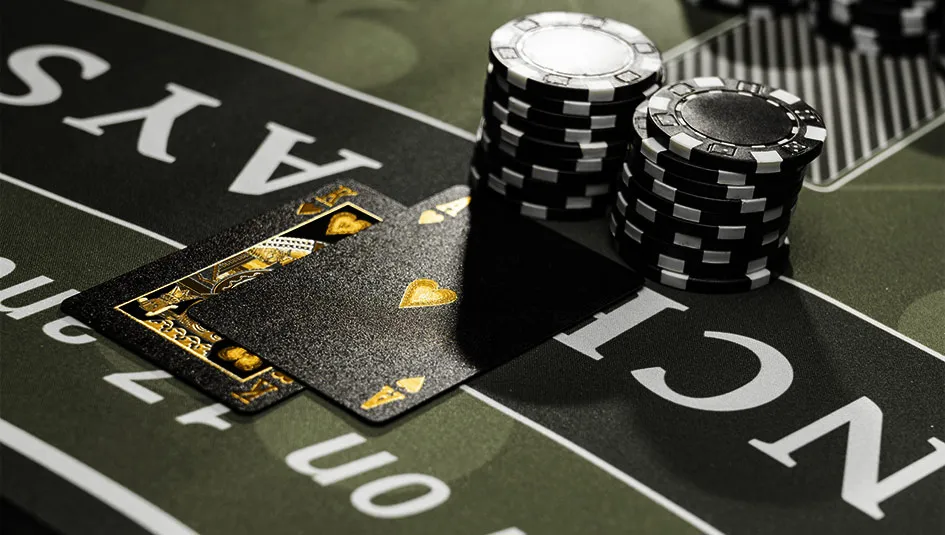The Basic Rules of Blackjack
In Blackjack, the aim of the game is to build a hand that is closer to 21 than the dealer’s hand. If a hand exceeds 21, it goes bust, which means it automatically loses. The hand that is closer to 21, without exceeding it, wins the round.
The game is played with at least one deck of cards, however, there are many variants that play with four, six or eight decks. All numbered cards are worth their face value while picture cards (Jack, Queen, King) are worth 10. Aces are special cards in blackjack as they can be worth 1 or 11.
The strongest possible hand is one that is exactly 21 and is formed from two cards. This is known as Blackjack. Blackjack is formed by holding an Ace with a 10-value card. If the player’s hand defeats the dealer’s and the player does not have Blackjack, the payout is 1:1. Should the player have Blackjack, the payout is 3:2. However, if the player’s hand is equal to the dealer’s, including if the dealer has Blackjack as well, the bet is returned as a push.
In most variants of blackjack, the player will receive two face-up cards and the dealer will show a face-up card. In some variants, the dealer will also take a face-down card. In other versions, the dealer waits until the player has completed their turn before taking their second card.
If the dealer is showing an Ace, players may have the option to place an Insurance Bet. This costs half of the player’s stake and pays 2:1. It guarantees money back if the dealer has Blackjack.
After receiving their first two cards, players will have the choice to perform one of the following actions:
- Hit – If the player hits, they take an additional card. The player can hit as many times as they like, but they must be wary not to go bust.
- Stand – If the player stands, they do not receive any further cards. Instead, they leave their hand as it is and the round continues to the next position.
- Double Down – If the player Doubles, they will receive a card and immediately stand. When Doubling, the player doubles their stake.
In most versions of Blackjack, the player will also be able to split if they receive a pair. When the player splits, they separate the two cards and play them as individual hands. In doing so, the player also doubles their bet.
When to Hit or Stand – The Basics of Blackjack
Hit and Stand are the main actions in Blackjack. Most seasoned blackjack players will know whether to hit or stand on a specific hand almost immediately based upon the dealer’s face-up card and the cards in their hands. Below, we have a basic guide to explain when you should hit and when you should stand. Bear in mind, this will vary slightly depending on the blackjack variant that you are playing and you should look at a strategy chart for the specific variant. Nonetheless, the following will hold true for the majority of games.
- If the dealer is showing an Ace, you should hit if you have 16 or lower. If you have 17 or higher, you should stand.
- If the dealer is showing a 10-value card, you should hit if you are holding a 12, 13, 14, 15 or 16. If you have 17 or higher, you should stand.
- If the dealer is showing a 7, 8 or 9, you should hit when holding 5, 6, 7, 8, 9, 12, 13, 14, 15, 16. If you build a hand that has a total of 17 or more, you should stand.
- If the dealer is showing a 4, 5 or 6, you should avoid busting at all costs. In this scenario, you should hit on 5, 6, 7, 8 but stand on 12 or more.
- If the dealer is showing a 3, you should hit on 5, 6, 7, 8 and 12, while standing on anything 13 or over.
- If the dealer is showing a two, you should hit on 5, 6, 7, 8, 9 and stand on anything 13 or over.
When to Double or Split – The Basics of Blackjack
The basic rules around knowing when to double down are fairly easy to learn. Whenever you double down, you are basically confident that your hand will beat the dealers. If you have a hand total of 10 or 11, more often than not, you are going to double down. This is because there is approximately a 30% chance of hitting a 10-value card, making a high hand. Keep in mind, some blackjack variants only allow players to double down on a hand worth 9, 10, or 11. Other variants are more flexible that allow you to split on any hand total.
If you are dealt a pair, you are offered the chance to split. In most blackjack variants, splitting aces and receiving a 10-value card counts as 21, not Blackjack. Whenever you split a pair of cards, you double your bet and separate one hand into two.
Statistically speaking, you must always split a pair of 8s and a pair of Aces. A pair of 8s are worth 16, however, by splitting them, you will have a strong chance of forming one, if not two, 18-point hands. As for a pair of Aces, they count as 12 combined. However, if you split them, you will have an opportunity to form a hand of 21.
- If you are dealt a pair of 10s, you should stand, rather than split them.
- If you are dealt a pair of 9s, it is best to split them if the dealer is revealing a 2, 3, 4, 5, 6, 8 or 9. It is best to stand if the dealer has a 7, 10 or Ace.
- If you are dealt a pair of 7s, it is best to split them if the dealer is showing a 2, 3, 4, 5, 6 or 7.
- If you are dealt a pair of 6s, it is best to split if the dealer is showing a 2, 3, 4, 5 or 6.
- If you are dealt a pair of 5s, you should double down if possible or hit instead of splitting the cards.
- If you are dealt a pair of 4s, it is best to split them if the dealer is showing a 5 or a 6. In any other case, it is best to hit.
- If you are dealt a pair of 3s, it is best to split them if the dealer is showing a 2, 3, 4, 5, 6 or 7. Otherwise, you should hit.
- If you are dealt a pair of 2s, it is best to split them if the dealer is showing a 2, 3, 4, 5, 6 or 7. Otherwise, you should hit.
Once again, remember that the above are general guidelines that may not hold true for every blackjack variant.
Blackjack Strategy Charts
One way that you can understand when to hit, stand, double or split is by using blackjack strategy charts. These display the statistically optimal action to take in any situation. However, it is important to understand that strategy charts for blackjack games will vary, depending on the rules of the game, so you need to ensure that you are using the right chart for the variant that you are playing
As mentioned before, some games may not permit doubling on certain hands. There are also many blackjack games that have different rules for the dealer, regarding when they hit or not. In almost every blackjack game, the dealer will hit on 16 or lower and stand on 17 or higher. However, if the dealer has a Soft hand (a hand that contains an Ace that acts as an 11), they may be required to hit until they have a hard 17 or higher, or go bust. These small differences make a difference to the strategy so it is important to be aware of them.
Using blackjack strategy charts is not difficult at all. Furthermore, it is also permitted by land-based and online casinos, as it does not break any rules. While it may feel cumbersome at first, you will soon get used to it, and it is certainly worth the effort.
Minimum Effort for Maximum Returns
Using basic strategy when playing blackjack is not at all difficult. You are even allowed to consult the strategy charts while you play. By doing so, you are giving yourself the best possible chance of winning. With an absolute minimum of effort, you can help yourself towards the biggest possible rewards.

 The Best Roulette Bets for New Players
The Best Roulette Bets for New Players Unusual Casino Games from Around the World
Unusual Casino Games from Around the World